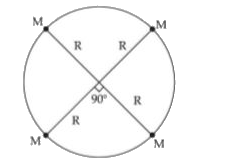A particle moves in a circular orbit under the action of a central attractive force inversely proportional to the distance r. The speed of the particle is
Proportional to r2
Independent of r
Proportional to r
Proportional to 1/r
The correct Answer is:B
F=K1r⇒kr=mv2r⇒v=√km
So mdependent of r
Topper's Solved these Questions
- MOTION IN A PLANE BOOK - PHYSICS WALLAHCHAPTER - MOTION IN A PLANE EXERCISE - NEET Past 5 years Questions
10 Videos
- MOTION IN A PLANE BOOK - PHYSICS WALLAHCHAPTER - MOTION IN A PLANE EXERCISE - NEET Past 5 years Questions
10 Videos
- MECHANICAL PROPERTIES OF MATTERBOOK - PHYSICS WALLAHCHAPTER - MECHANICAL PROPERTIES OF MATTEREXERCISE - NEET Past 5 Yeats Questions
16 Videos
- MOTION IN A STRAIGHT LINEBOOK - PHYSICS WALLAHCHAPTER - MOTION IN A STRAIGHT LINEEXERCISE - NEET Past 5 Years Questions
5 Videos
Similar Questions
Four particles each of mass M, move along a circle of radius R under the action of their mutual gravitational attraction as shown in figure. The speed of each particle is :

View SolutionA particle revolves round a circular path. The acceleration of the particle is inversely proportional to-
View Solution
Knowledge Check
A particle moves in a circular orbit under the action of a central attractive force which is inversely proportional to the distance 'r' . The speed of the particle is
Aproportional to r2BIndependent of rCproportional to rDproportional to 1/rA particle moves in a circular orbit under the action of a central attractive force inversely proportional to the distance r. The speed of the particle is
AProportional to r2BIndependent of rCProportional to rDProportional to 1/rA particle executes circular motion under a central attractive force inversely proportional to distance R. The speed of the particle is
ADependent on RBDependent on R2CIndependent of RDDependent on 1/R
A particle is moving with a uniform speed in a circular orbit of radius R in a central force inversely proportional to the nth power of R. If the period of rotation of the particle is T, then :
View SolutionA particle revolves round a circular path. The acceleration of the particle is inversely proportional
View SolutionA particle revolves around a circular path. The centripetal acceleration of the particle is inversely proportional to
View SolutionA particle is moving in a circular path of radius r under the action of a force F. If at an instant velocity of particle is v, and speed of particle is increasing, then
View SolutionA particle is moving with uniform speed along the circumference of a circle of radius R under the action of a central fictitious force F which is inversely proportional to R3. its time period of revolution will be given by :
View Solution
